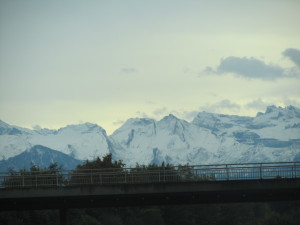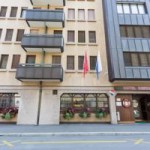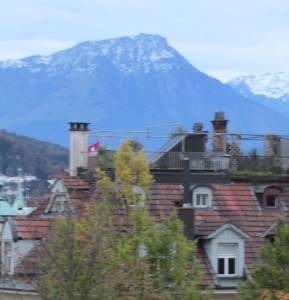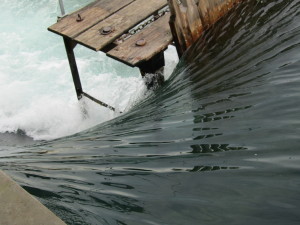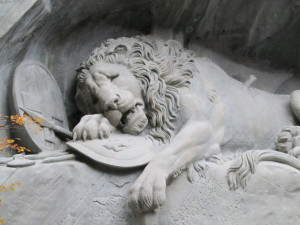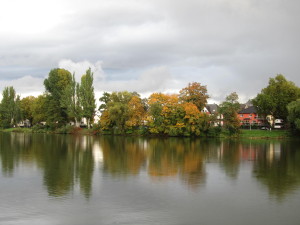buy Aurogra with no prescription We left Vaduz, slipped into Austria our 7th. country for a bit, and headed for the town of Fussen in Germany on the banks of the River Lech. The Via Claudia Augusta went right through the middle of town. In fact in the late 1950’s they discovered actual Roman ruins. The Via Claudia Augusta connected Altino (present day Venice) to the River Danube with a military road than ran through Fussen and Augsburg. Near the end of the third century a camp was built on the hill where the High Palace sits today. We walked the Reichenstrasse, the main shopping street, where historic patricians’ houses were built side by side along the identical path of the original Via Claudia Augusta. It certainly looked like a pedestrian way, barely wide enough for cars, but a few autos made their way through the crowds. Many of the structures were highly decoratively painted to give their flat surfaces more style. At the end of the street, the town fountain was a statue of St Magnus, the patron saint of the town. We visited the courtyard of the High Palace, the former residence of the Augsburg bishops/princes. The facades facing the courtyard are highly decorated with illusionist paintings giving the “palace” far more architectural interest than it had. The structure now houses a gallery. The entrance to St Mang Monestery and Church, which dates back to the 9th century, was under construction and messy to access so we skipped it. We took a diversion by the “brotmarkt” the bread market, though to be the origin of the medieval town. Took a photo of the lute-makers fountain honoring Fussen as the cradle of lute-making in Europe. We left Fussen, heading to the Hotel Muller in Hohenschwangau, our next destination. Our very comfortable room had a view out the window of the Hohenschwangau Castle we’ll visit tomorrow afternoon. In the morning, we’ll visit the Neuschwanstein Castle, the famous original after which Walt Disney fashioned his castle. In the bright sunshine, we had a glass of rose in the beer garden. We walked down to the Alpsee, a lake with water so clear, we saw a pike chasing a school of small fish. We looked in a few souvenir shops, tried on fashionable German hats – bought none when we realized we’d look foolish at home wearing one!
Paris Arrondissements Map

Search this site
Tag cloud
Locks of Love Latin Quarter Le Boat Seine Notre Dame Eiffel Tower La Cuisine Paris La Bovida Argens-Minervois Cafe du Metro Marche President Wilson BHV Place Vendome Black Forest Ramstein Tamaris Vosages Mountains River Queen Cartier Gare du Nord Walking Tour Chalon-sur-Soane Aubrac Beef A. Simon President Wilson Market RER E. Dehillerin Cafe du Centre Pont de l'archevêché Aligot Guerlain Kaiserslautern Jardin Des Plantes Lockkeeper flea market Trocadero TGV Potato Leek Soup navigo Les Deux Magots Mora Locks La Cordonnerie Cookware Puces de VanvesMeta
-
Recent Posts
- Chile – Puerto Natales
- Chile – Puerto Natales
- Chile – Torres del Paine
- Chile – Torres del Paine National Park
- Chile – Torres del Paine
- Chile – Magdalena Island
- Chile – Punta Arenas
- Chile – Fishing in Maullin River
- Chile – Puerto Varas
- Chile – Puerto Varas
- Chile – Puerto Varas
- Chile – Wine Tasting, Valparaiso and Viña del Mar
Categories
- 5 most secret streets in Paris (2)
- 8th Arrondissement (1)
- Africa (10)
- Alexandria – Egypt (1)
- Aligot (1)
- Alpirsbach (1)
- American Library Paris (1)
- Amsterdam (8)
- Argens-Minervois (2)
- Aswan (2)
- Augsburg (1)
- Austria (1)
- Baden-Baden (1)
- Baguettes (3)
- Bakeries (7)
- Ballet (1)
- Baltimore Washington Airport (4)
- Basel Switzerland (1)
- Battle of the Bulge (1)
- Bernkastel (2)
- Bernkastel-Kues (3)
- Berthe Morisot (1)
- Bethlehem (1)
- Beyond Paris (1)
- Beziers (2)
- Bistros, Cafes, Brasseries (14)
- Black Forest (1)
- Bled (1)
- Boppard (2)
- Bouzies (1)
- Branges (1)
- Bread (1)
- Breisach (2)
- Brioche (1)
- British Virgin Islands (1)
- Brittany (3)
- Bruge (3)
- Brussels (5)
- Burgundy (1)
- Cafe (4)
- Cafe Normale (1)
- Cahors (2)
- Cairo (7)
- Canal Cruising in the South of France (1)
- Carcasssone (2)
- Carnac (3)
- Cathedral (1)
- Charles de Gaulle Airport (1)
- Cheese (1)
- Chile (12)
- Chileo (1)
- Christmas Market (1)
- Civitavecchia (2)
- Cochem (3)
- Cologne (2)
- Colombiers (2)
- Comte (1)
- Concerts (1)
- Cooking (7)
- Cooking Class (1)
- Corfu (2)
- Croatia (13)
- Croissants (3)
- Crusing Guide (2)
- Dijon (7)
- Dordogne (8)
- Doubs River (1)
- Douelle (1)
- Dubrovnik (3)
- Edfu (1)
- Ediger-Eller (3)
- Egypt (3)
- etc (1)
- European Central Court (1)
- Exhibits (1)
- flights (1)
- Fonserannes Staircase (1)
- Food Sources (3)
- Fourme d'Ambert (1)
- France (40)
- Freiburg (1)
- Freudenstadt (1)
- Fussen (1)
- Gaetz (2)
- Gardens (6)
- Gare L'Est (1)
- Gare Lyon (1)
- Geneva (2)
- Germany (13)
- Getting around (1)
- Giza (1)
- Grand Palace (1)
- Greco-Roman Alexandria – Egypt (1)
- Hausach (1)
- Hesse (2)
- Historic Sites and Monuments (9)
- Hohenschwangau (2)
- Home in Virginia (5)
- Hvar (2)
- I AS du Fallafel (2)
- IBIS (1)
- Ile De La Cite (1)
- Islands (1)
- Italy (4)
- Jerusalem (6)
- Jewish Quarter (1)
- Karnak Temple (1)
- Katie (1)
- Kayserberg (1)
- Kenya (10)
- Kiserslautern (4)
- Koblenz (3)
- Kotor (1)
- Kumrovec (1)
- Lahr (1)
- Lake Bled (2)
- Landsthuhl (1)
- Le Somail (1)
- Lewa (1)
- Ljubljana (1)
- Llanquihue (1)
- Locks of Love (3)
- Lodging (1)
- Lot River (7)
- Lucerne Switzerland (2)
- Luxembourg (1)
- Luxor (2)
- Macrons (2)
- Madeleine (1)
- Mara North (1)
- Marché Couvert de Passy (2)
- Marche au Puce (2)
- Markets (10)
- Massai Mara (4)
- Midi Canal (9)
- Midnight in Paris (1)
- Mike & Pat's Market Adventures (2)
- Molecular Gastronomy (1)
- Mommantra (1)
- Montenegro (1)
- Montmartre (2)
- Montmartrobus (1)
- Morbier (1)
- Moscenice (1)
- Moselle River (4)
- Munster (1)
- Museums (12)
- Music (1)
- Nairobi (2)
- Navigo Decouverte (1)
- Neuschwanstein (1)
- Newark, NJ (1)
- Nile River Egypt (2)
- Notre Dame (1)
- Old Town Gate (1)
- Paris (106)
- Paris 10th (4)
- Paris 11th (2)
- Paris 12th (3)
- Paris 13th (3)
- Paris 14th (3)
- Paris 15th (4)
- Paris 16th. (24)
- Paris 18th (3)
- Paris 19th (2)
- Paris 1st (17)
- Paris 20th (3)
- Paris 2nd (9)
- Paris 3rd (2)
- Paris 4th (3)
- Paris 5th (4)
- Paris 6th (3)
- Paris 7th (10)
- Paris 9th (3)
- Passy (5)
- Pom Cannelle (1)
- Ponza (2)
- Porte de Versailles Exhibition Centre (1)
- Prague (1)
- Presidential Inn Andrews Air Force Base (2)
- Provence (8)
- Puerto Natales (3)
- Puerto Varas (4)
- Punta Arenas (4)
- PuyCalvel (1)
- Quimper (1)
- Raileurope (2)
- Raileurope ekit (1)
- Ramstein Air Force Base (8)
- RER (1)
- Restaurants (5)
- Rhine River (1)
- Richmond (1)
- Riquewihr (3)
- River Cruise (5)
- River Cruising (3)
- Roquefort (1)
- Rovinj (1)
- Rudesheim (2)
- Safety (1)
- Sailing (1)
- Saille River (1)
- Saint Ouen (2)
- Sambura (4)
- Santiago (3)
- Schloss Hohenschwangau (1)
- Schramberg-Talstadt (1)
- Seille River (1)
- Senlie (1)
- Shopping (7)
- Shops (1)
- Sicily (1)
- Slide Shows (1)
- Slovenia (3)
- Slovnia (1)
- Soane River (6)
- Sorrento (2)
- Space-A (3)
- Space-A Travel (5)
- Speyer (2)
- St Germain en Laye (1)
- St Siffret (3)
- Strasbourg (2)
- Switzerland (2)
- Taormina (2)
- Technology (1)
- Ter Train (1)
- TGV (13)
- THALYS (1)
- Tomme d'Auvergne (1)
- Tommes (1)
- Torres del Paine (2)
- Train (7)
- Tramontane (1)
- Travel Documents (1)
- Travel Modem (1)
- Travel Tips (2)
- Triburg (1)
- Trier (1)
- TSA (1)
- Uncategorized (12)
- United Air Lines (1)
- Vacations (1)
- Vaduz Lichtenstein (1)
- Vannes (3)
- Venice Italy (1)
- Ventenac-en-Minervois (1)
- Vers (1)
- Versailles Rive Gauche (1)
- Videos (1)
- Vogelweh (1)
- Walks (1)
- Wardrobe (2)
- Web Resources (1)
- WWII cemetery in Luxembourg (2)
- Zadar (1)
- Zagreb (2)
- Zell am Harmersbach (3)
Archives
- February 2025
- September 2024
- August 2024
- February 2024
- January 2024
- February 2023
- January 2023
- October 2021
- September 2021
- September 2020
- March 2020
- April 2019
- March 2019
- December 2018
- June 2015
- May 2015
- September 2014
- March 2014
- February 2014
- January 2014
- December 2013
- November 2013
- October 2013
- September 2013
- May 2013
- February 2013
- March 2012
- February 2012
- October 2010
- September 2010
- August 2010
- October 2009
- October 2008
- September 2008
- December 2007
- September 2005
- November 2003
- October 2000
Recent Comments
- Caren Fields` on Our Friends
- Glenn on Sailing the BVIs – Thanksgiving 2003
- Carol Shoemaker on Paris/Germany 2014, Day 26 Headed to Ramstein
- admin on Paris Day 16 (Museum)
- Carol Shoemaker on Paris Day 16 (Museum)

